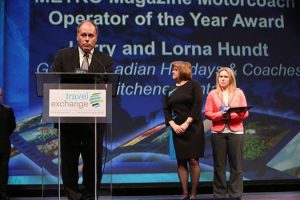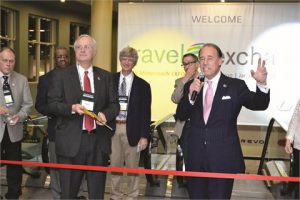Overcoming speed bumps on the way to a successful EXPO
The road to a successful show and increased non-dues revenue can be bumpy, as the United Motorcoach Association (UMA) and its event partner, NaylorCMG recently experienced. But a few speed bumps don’t signal a dead end.
 UMA is North America’s largest association of professional bus and motorcoach companies. Founded in 1971 as the United Bus Owners of America, UMA’s membership now includes more than 900 motorcoach companies. These members include small companies that provide tours and charters, and larger fleets that operate municipal route services, larger tours and cross-country trips. Motorcoach travelers generate more than $55 billion annually in economic transactions. UMA builds supplier relationships, promotes legislation beneficial to the industry and encourages the exchange of information that improves operations efficiency. Another 250 motorcoach manufacturers, suppliers and related businesses are associate members.
UMA is North America’s largest association of professional bus and motorcoach companies. Founded in 1971 as the United Bus Owners of America, UMA’s membership now includes more than 900 motorcoach companies. These members include small companies that provide tours and charters, and larger fleets that operate municipal route services, larger tours and cross-country trips. Motorcoach travelers generate more than $55 billion annually in economic transactions. UMA builds supplier relationships, promotes legislation beneficial to the industry and encourages the exchange of information that improves operations efficiency. Another 250 motorcoach manufacturers, suppliers and related businesses are associate members.
UMA and NaylorCMG have worked together on the annual Motorcoach EXPO since 2001, when UMA approached NaylorCMG for help reviving their non-dues revenue stream through improved attendance and exhibitor participation. The Motorcoach EXPO has traditionally been a premier event where the industry’s original parts manufacturers (OEMs), and auxiliary service providers converge with tour bus operators for a few days of learning, networking and community. Revenue raised through the EXPO helps UMA carry out its purpose of promoting the interest and welfare of privately owned motorcoach operators and tour suppliers.
This community takes work and money to sustain, however, and CMG collaborated steadily with UMA beginning with the 2003 EXPO to implement changes that enhanced the show experience for both sides of the exhibitor/attendee coin while earning UMA the funds it needs to produce a top-quality show. They began locating shows in major cities (usually warm cities: EXPO always takes place in the middle of winter). Mini-buses were introduced to the show floor in 2004 in response to demand for transportation for smaller groups, and in 2005 and 2006 CMG tested a “Destinations and Attractions” section that is now located within NTA’s (formerly known as the National Tourism Association) annual conference.

Starting in 2013, UMA partnered with NTA to co-locate EXPO with NTA’s annual convention, to provide a greater value for everyone attending. The decision to co-locate the new “Travel Exchange” show was made on the basis of UMA and NTA’s members providing complementary products and services: UMA members are the motorcoach operators and the suppliers who keep their fleets running, and NTA members are the tour operators, destination representatives and attraction managers that organize and host group travel. The Travel Exchange co-location benefits the entire group travel industry by bringing all interested parties together for education and relationship building.
NaylorCMG’s strategic exhibitor research and sales earned UMA a 38 percent increase in exhibit revenue between 2006 and 2011, thanks to upgrade incentive packages and repeat exhibitor programs like first rights to premier spaces. On-site exhibit sales continued to increase year over year, demonstrating that the changes CMG and UMA worked to implement were translating into value exhibitors responded to and appreciated.
During the 2013 show, as CMG began to take reservations for 2014’s exhibit spaces, it soon became clear certain economic conditions would have some of the larger exhibitors renewing for 2014 in considerably smaller booth sizes than they had traditionally taken in the past. This left CMG with a lot of empty space and UMA with the prospect of losing the revenue momentum it had built up over the past decade—not to mention a funding shortage for the receptions, meeting spaces, education, speakers , food and beverage, that make up the overall experience at the show.
“We quickly developed a strategy to further diversify the exhibitor base, which meant reaching out to smaller exhibitors who might consider upgrading their show presence to a larger space, or could exhibit for the first time,” explained David Petrillo, sales manager at CMG. As with many shows, smaller spaces sell at a higher price per square foot than larger spaces. If the team could sell many small- to medium-sized spaces to smaller motorcoach companies, UMA had the chance to make up the projected shortfall and stay on track with its sales and show experience goals.
“The universe of the OEM segment is finite, but by reaching deeper into other segments, we could further diversify the exhibitor base and provide more opportunities to smaller companies,” said Petrillo.
UMA stayed closely in touch with CMG’s staff as they prodded through the U.S.-based motorcoach community, pitching small- to medium-sized companies on the chance to secure exhibit space that was previously occupied. The association forwarded leads from industry media, other shows, and personal contacts to help CMG reach as many companies as possible and reach the show’s space and revenue goals. CMG aligned its exhibit sales and marketing messages with materials UMA created to promote show attendance to enhance the synergy between the two EXPO portions and amplify the value attendees and exhibitors would attain by participating.
The plan worked. Any time the CMG team ran into objections, UMA fortified their offer prospect with additional show information, industry statistics, and insight into members’ perspective that helped CMG better relate the value of exhibiting at EXPO. Small and medium OEMs and industry suppliers purchased smaller spaces at a higher exhibit rate, helping CMG and UMA recruit 184 paid exhibitors for the 2014 show floor: a 13 percent increase over the 2013 show, which surpassed the 2014 exhibit sales revenue goal. As an added benefit, CMG cultivated a more diversified set of exhibitors with whom attendees could network and set up vendor relationships—a set that probably wouldn’t have been so well-rounded if CMG wasn’t pushed to reach a more diverse prospect list.
“Our focus shifted from the larger, traditional standbys to new exhibitors and a better representation of products and services that resulted in a better shopping experience for attendees,” said Petrillo. “We’re very pleased with how the show floor shaped up.”
“UMA engages us as a true partner, which makes all the difference when striving to assemble a quality exhibitor base for EXPO,” he added.
Getting creative with the exhibitor list also helped UMA take one more step toward its long-term goal of engaging more international operators and supplies in the U.S. While the U.S. operator community is finite, there is plenty of opportunity globally for UMA to earn more non-dues revenue by contracting with foreign-based companies to exhibit at EXPO. UMA is perfectly positioned to help them learn U.S. manufacturing and operating regulations, identify maintenance networks, and find distributors—a huge boon for international companies who face a steep learning curve upon entry to the U.S. market. Attending and exhibiting at Travel Exchange and the Motorcoach EXPO can be one of the first and biggest steps international companies take to establish US operations.

“As part of the UMA leadership team, I was excited to see all the new exhibiting companies that lead to a richer experience for attendees at our 2014 event,” said Larry Hundt. “But as a coach operator, I was even more thrilled to see the additional diversity of products and services offered by exhibitors. Travel Exchange will continue to be one of our company’s annual trips.”
CMG and UMA reached out to companies in Europe and South America, in hopes of helping them begin a U.S. presence through EXPO. While there are a number of international OEMs and suppliers represented through U.S. distributors, only a handful operate independently in the U.S. and exhibit under its own name. But after two years in a row of attending EXPO, Irizar, an OEM based in Spain, has committed to exhibit at EXPO in 2015 in New Orleans and reserved 6,000 square feet. This company will complement the U.S.-based large OEMs and the cadre of smaller, diverse companies who enjoyed their 2014 exhibit experience enough to already reserve space for next year’s show in New Orleans.
“In addition to all the support from UMA throughout the year, they also provide quality educational and networking experience and host EXPO in exciting locations like L.A. and New Orleans, which makes generating non-dues revenue (exhibit space sales) for the association very possible,” Petrillo said. “With our solid partnership and renewed strategic focus, I believe we will continue build on the success of the 2014 show as we head to New Orleans in 2015,” he said.

“The true measure of a successful show is delivering the audience,” said UMA President and CEO Victor Parra. “For both attendees and exhibitors this means an audience relevant to their business with whom they can create mutually beneficial relationships. With our intended exhibitor expansion and our commitment to assist international OEMs and suppliers as they establish operations in the U.S., we are confident we can continue to deliver a relevant audience while achieving the non-dues revenue goals for our association that allow us to be the most important resource and advocacy leader in the motorcoach industry.”

